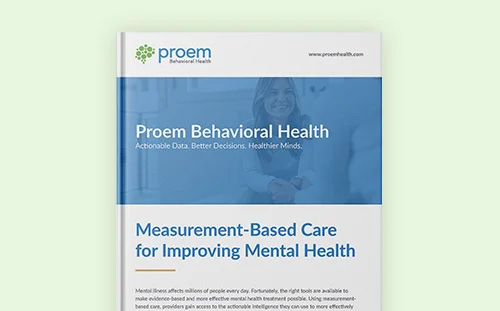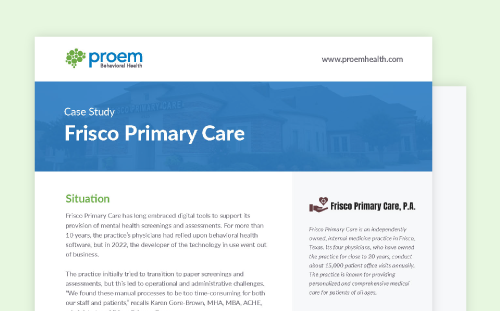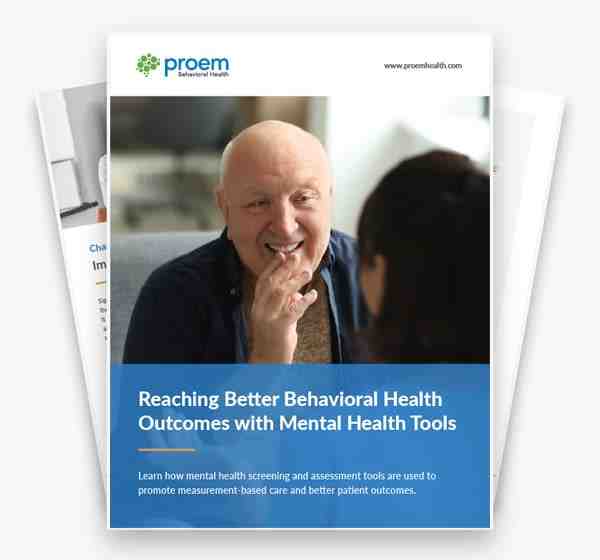Reaching Better Behavioral Health Outcomes
with Mental Health Tools
Well before the pandemic, mental health concerns were growing. Then COVID-19 arrived and disrupted all aspects of our lives. Many people found their mental health suffering. Others already struggling with their mental health saw their challenges increasing. The pandemic has shined an even brighter light on an existing need: identifying and treating disorders and illnesses affecting mental health.
Despite the need for increased mental health services, little about the way those services are delivered has changed over the years. In essentially all other areas of healthcare, well-defined, evidence-based protocols guide practitioners as they diagnose and treat physical illness. But in mental health, there is no such consistent or comprehensive process. In fact, outdated, single-dimensional mental health screeners can frequently lead providers to misdiagnose major depressive disorder and generalized anxiety disorder. Furthermore, since it is often difficult to follow up with patients, many providers simply do not know if a patient improves and have limited means of collecting the data needed for measurement-based care and quality improvement.
Providers and organizations need tools that can help produce better outcomes for their patients experiencing mental illness. Fortunately, a new breed of digital solutions is emerging that offers a streamlined way for behavioral health providers to get the right answers at the right time to enable the right mental health outcomes.

Chapter 1:
Importance of Mental Healthcare Screening
Significant misconceptions exist among the public about mental illness. That's why it is essential for clinicians to be aware of and share key facts about mental health when working to educate and engage those patients they are working to support.
Why Is Mental Health Important? Key Statistics and Facts
When patients learn of their mental health diagnoses, many believe mental health illnesses are untreatable conditions that will permanently alter their lives. But when treatment planning is informed by outcome measures and measurement-based care, their chances for living more productive lives increase dramatically. Let’s examine some other misconceptions.
Mental Health Fact:Prevalence Assumptions Are Often Wrong
The public tends to underestimate certain mental health concerns while overestimating the prevalence of others. Data shows that anxiety and depression are the most common mental health concerns, accounting for almost one-third of conditions in recent years. Annual prevalence among U.S. adults by condition was as follows pre-pandemic:
-
Anxiety disorders: 19.1%> (estimated 48 million people)
-
Major depressive episode: 8.4% (estimated 21 million people)
-
Posttraumatic stress disorder (PTSD): 3.6% (estimated 9 million people)
-
Bipolar disorder: 2.8% (estimated 7 million people)
-
Borderline personality disorder: 1.4% (estimated 3.5 million people)
-
Obsessive compulsive disorder (OCD): 1.2% (estimated 3 million people)
-
Schizophrenia: < 1% (estimated 1.5 million people)
This distribution has changed since the COVID-19 pandemic. In fact, Kaiser Family Foundation reported more than 30% of U.S. adults were reporting symptoms of anxiety or depression in December 2021 — nearly triple pre-pandemic levels.
Mental Health Fact:Mental Health Screening of Youth Is Important
The public often mistakenly views mental illness as an adult concern, but many mental health facts for youth counter this misconception. For instance, according to MentalHealth.gov, “Half of all mental health disorders show the first signs before a person turns 14-years-old, and three quarters of mental health disorders begin before age 24.” Common mental health conditions in youth include attention deficit hyperactivity disorder (ADHD), autism, bipolar disorder, conduct disorder, depression, grief, suicide and substance abuse.
When the prevalence of mental health issues among young people is not acknowledged, many individuals will not receive timely treatment or no treatment at all. Federal statistics show less than 20% of children and adolescents with diagnosable mental health problems receive the treatment they need.
During the pandemic, mental health concerns in America’s youth became a more significant concern with the U.S. Surgeon General, which issued an advisory on the topic. Adolescent girls may be particularly at risk. As the Centers for Disease Control and Prevention (CDC) reports, this group represents the largest increase in emergency room visits for mental health conditions in recent years.
Mental Health Fact:Mental and Physical Health Are Linked
Many people believe that mental and physical health are distinct. Yet mental health and physical health statistics demonstrate the two are often linked. The CDC reports that depression and other mental health conditions can increase the risk of diabetes, heart disease and stroke. People with depression have a 40% higher risk of developing cardiovascular and metabolic diseases than the general population. Conversely, suffering from various chronic conditions can increase the risk for mental illness.
Of note, not only has the pandemic exacerbated mental health concerns across multiple demographics, but evidence suggests patients with COVID have an increased risk of developing mental health problems, according to a BMJ study covered by The New York Times.
Why Are Mental Health Screening Tools Important?
Fortunately, solutions are available that can help improve the early identification and diagnosis of mental health issues and get patients on a path to treatment sooner. Let's examine the concept of mental health screening and how behavioral health organizations should approach selection of the mental health screening tools that will best serve them and their patients.
What Is Mental Health Screening?
Screening is used as a means of identifying people who may be at risk for certain behavioral health conditions or disorders. But that's not all. As the American Psychological Association (APA) notes, screening is "part of comprehensive healthcare and population health as described by the Patient Protection and Affordable Care Act.” Furthermore, as part of a routine clinical visit, clinicians with the proper support tools can screen patients to identify the need for additional evaluation.
Mental Health Assessment, Diagnosis and Symptom Monitoring
Following an initial screening, an assessment offers a more detailed look at an individual by integrating the results of various psychological tests as well as clinical interviews and observations of the patient.
Using data from screening, assessments and other evaluations, the provider makes a diagnosis of the condition(s) the patient is suffering from. Once a diagnosis is determined, clinicians will work with the patient to create a treatment plan and monitor symptoms and improvements.
Common Behavioral Health Disorders Identified with Mental Health Screening
There are numerous behavioral health disorders that may be identified during the initial screening process. According to Medline Plus, these disorders include:
-
Depression and mood disorders
-
Anxiety disorders
-
Eating disorders
-
Attention deficit hyperactivity disorder (ADHD)
-
Post-traumatic stress disorder (PTSD)
-
Substance use and addictive disorders
-
Bipolar disorder (previously referred to as manic depression)
-
Schizophrenia and psychotic disorders
What Makes a Good Mental Health Screening Tool?
When screening for mental health disorders, clinicians must recognize that not all mental health screening tools are created equal. Some are more effective and efficient than others. To properly evaluate the types of mental health screening tools and their value, Emory University School of Medicine identifies four key qualities:
-
Reliability: whether the tool produces consistent results
-
Validity: the ability to consistently discriminate or distinguish between an individual with a disorder and one without
-
Sensitivity: the accuracy of the tool in identifying the disorder
-
Specificity: the accuracy of the tool in identifying those who do not have a disorder
The best mental health screening tools embody each of these characteristics and, as a result, can give clinicians confidence in the tools’ ability to appropriately screen and assess their patients.
Back to Top ↑

Chapter 2:
Overview of Mental Health Assessment Tools
It’s essential to understand the main components of mental health assessments to better ensure you select the ideal evidence-based tools for your organization and effectively leverage these helpful solutions.
What Are the Five Main Components of Mental Health Assessments?
Mental health assessments are examinations used to ascertain whether a person is healthy psychologically and socially and is generally developing and/or living well. Critical at every stage of life, assessments are often used to screen for mental health disorders like depression or neurological diseases such as Alzheimer's.
What Is Included in a Mental Health Assessment
A "mental status evaluation" (MSE) is commonly used to assess a patient's behavioral and cognitive functioning and helps ensure an accurate psychiatric evaluation. When performed effectively, an MSE illuminates signs and symptoms of a mental illness or its risk factors. An MSE can also help determine a working diagnosis and establish areas of potentially worthwhile intervention.
Let's look at the five main areas of focus for performing an effective MSE.
-
General appearance and behavior
A patient’s appearance may provide clues about their mental state. Key factors include whether patients look appropriate for their chronological age, including how they dress, and whether they can maintain eye contact. In addition, assessing a patient’s appearance and behavior can help identify problems with alcohol and substance use.
-
Mood and affect
A patient’s mood and their affect — which refers to expressions reflected in movements or changes in voice tone, posture or stance — are related to emotion, and both should be aligned. The subjective and objective aspects of mood must be assessed.
-
Thought content
A health provider must ask direct questions to better determine a patient's train of thought. Are their thoughts logical or consistent? Are they blocking any thoughts? Through this process, providers can often detect negative feelings, such as hopelessness.
-
Cognitive functioning
Cognitive functioning relates to intellectual abilities. Assessing a patient’s capacity to read, write and immediately remember significant events in the recent past can help a provider determine if a patient can recognize familiar people and places. Cognitive functioning also includes the ability to focus or perform simple calculations.
-
Judgment and insight
Judgment is determined by how well a patient solves problems and makes informed choices. Insight is evaluated by gathering as much information as possible from the patient’s perspective. Topics covered can include the reasoning for a visit to a behavioral health specialist and an understanding of the challenges that have led to the visit.
Building on the Mental Status Examination (MSE): Cognitive Assessment
After an MSE is used, a health provider can conduct a more thorough investigation using a cognitive evaluation in which neurological and psychological functions are assessed. The cognitive assessment evaluates:
-
Attention
-
Language
-
Memory
-
Praxis (i.e., the process by which a skill is enacted or the performance of an action)
-
Prosody (i.e., rhythm, stress, and intonation of speech)
-
Thought content
-
Visuospatial proficiency (i.e., ability to perceive and manipulate objects and shapes in space)
-
Executive function
-
Orientation
-
Thought process
-
Gnosia (i.e., ability to recognize and identify)
The cognitive assessment may also include a brief standardized tool, such as the mini-mental state examination (MMSE). The purpose of an MMSE can be better understood by comparing it to the MSE.
What Is the Difference Between MSE and MMSE?
Initially, a clinician will use an MSE for evaluation. Other standardized assessment tools may be used if more comprehensive examination is needed. Enter the MMSE. Whereas the MSE is a brief neuropsychological screening test, the MMSE is used for more detailed testing in the cognitive section of MSE to help remove ambiguity in the initial screening.
Now let's examine the different types of assessment tools in more detail.
Standardized Mental Health Assessment Tools, PDFs and Checklists
Professionals use various approaches to understand mental health and evaluate the extent of a mental disorder. Assessment tools are among the most reliable tools available to mental health professionals for gathering patient information.
What Are the Different Types of Mental Health Assessments?
The most common standardized mental health assessment tools used to diagnose mental disorders include the following:
-
Clinical assessments and mental health screening questionnaires
These tools evaluate patients’ medical, physical, psychological, cognitive and behavioral history as well as their current conditions to diagnose the presence of mental disorders. The assessment can be initiated by a mental health expert or patient.
-
Clinical interview
In a clinical interview, the mental health professional can observe the patient’s behavior and reactions to real-life situations — information that cannot be gleaned through a formal test.
-
Psychometric testing
Formal personality, cognitive, psychological, behavioral and emotional function tests are examples of psychometric testing. Although critical for diagnosing mental health disorders, these tests require specialized training to assess, score and interpret.
-
Physical and laboratory testing
Physical and laboratory tests are meant to verify that the patient doesn’t have physical problems causing a mental disorder. Areas covered can include a patient’s genetic profile, hormone levels, immune system, energy metabolism and nutritional status.
-
Multidisciplinary assessment
Based on techniques from multiple disciplines, this type of assessment helps to develop a clearer picture of the whole person. Some of the professionals who can assist include audiologists, speech therapists, religious specialists and vocational rehabilitation specialists.
Putting together a comprehensive list of assessment tools is a great step, but it's imperative that you follow this effort by determining the effectiveness of the tools you are considering before you select them.
A Checklist: Is This a Good Standardized Tool?
For a mental health assessment tool to be considered standardized, it must meet specific criteria for all standard outcome measures. Use this checklist to determine if the tool you are considering is a good, standardized assessment tool:
Is it comprehensive?
Is it evidence-based?
Is it reliable enough to produce consistent results?
Does it showcase validity when differentiating patients with mental disorders?
Does it document the sensitivity to identify a mental problem accurately over time?
Does it have the specificity to identify the people who don’t have a mental problem?
Does it focus on accuracy and ease of use?
Is it DSM-5 compliant?
Is it clinically validated?
Is it validated for use in diverse groups, especially ethnic minorities and those with low socioeconomic statuses?
Is it easy to score and read?
Is it digital?
The bottom line? Not all mental health assessment tools are created equal. Improperly developed and outdated tools can put your patients and organization at risk.
As we have seen, robust assessment and screening tools can help clinicians develop a working diagnosis and select potential interventions. But how do we know if those interventions are achieving the desired result? Outcome measures play an important role in assessing the effectiveness of care plans. Next, we will examine how measurement-based care is playing an increasingly significant role in behavioral health.
Back to Top ↑

Chapter 3:
Improving Mental Health Care: The Move to Measurement-Based Care
It’s become generally accepted that to deliver optimal mental healthcare services, organizations must pursue evidence-based practices, measure progress and outcomes, and adapt care plans as needed.
What Is Quality Improvement in Healthcare? Role of QI in Mental Health
What can be done to help behavioral healthcare providers accomplish these crucial goals that contribute to better mental health diagnoses and outcomes for patients? Enter quality improvement.
What is Quality Improvement in Healthcare?
The Centers for Medicare & Medicaid Services (CMS) defines quality improvement as “the framework used to systemically improve care.” Quality improvement in healthcare aims to standardize processes and structure to:
-
reduce variation;
-
achieve predictable results; and
-
improve outcomes for patients.
Measurement is critical in developing systems that will decrease variation and strengthen outcomes. Within behavioral health, clinicians must be able to measure initial symptom levels, changes in treatment, and outcomes to inform best practices and identify opportunities for improvement.
Quality Improvement Tools in Healthcare: Systems of Measurement
Behavioral health lacks the observable and quantifiable vital signs available to other medical specialties focused on physical health (for example, measuring cardiac health through heart rate and blood oxygenation levels). As a result, behavioral health measures largely rely on self-reported assessments.
Examples of widely accepted self-reported data in behavioral health measurement may include information gathered through tools like screeners, diagnostic interviews and monitors that track behavioral experience or frequency of behaviors. Combined with consistent care practices that include clinical follow-up, this self-reported data should help predict outcomes at the patient population level. By using such data, clinicians can also take the most appropriate steps that will lead to better decisions and healthier minds. As such, data collection must be reliable, interpretable and scalable.
Measurement-based care (MBC) in behavioral health includes four components:
-
Administration of validated self-report measures to patients before treatment sessions
-
Clinician review of numerical and graphical scores over time
-
Feedback on this data back to patients
-
Collaborative evaluation of the results to determine maintenance or change in treatment course
How to Measure Quality Improvement in Healthcare
When measurement-based care is put into practice, the results can be powerful. MBC has been shown to affect the course of treatment through symptom monitoring, which enhances clinical judgments and patient-provider communications.
As researchers have demonstrated, when MBC is embedded into existing technologies and incorporated into the culture of treatment settings, significant improvement occurs in the quality of care provided. MBC offers insight into treatment progress, highlights ongoing treatment targets, reduces symptom deterioration and improves patient outcomes. When behavioral healthcare providers adopt the same measures and systems for measurement, developing evidence-based practices across patient populations becomes easier and more effective.
Quality Improvement Process in Practice
Government organizations like the U.S. Department of Health & Human Services’ Substance Abuse and Mental Health Services Administration (SAMHSA) and private companies like Proem Behavioral Health are working to identify quality measures in behavioral health and create a framework for improvement. The Office of Management and Budget (OMB) has approved technical specifications and data-reporting templates to collect the 32 quality measures listed in the certified community behavioral health clinics' (CCBHCs) certification criteria. CCBHCs and their states are required to collect 21 of the measures for SAMHSA’s demonstration program. The program is designed to integrate behavioral health with physical healthcare and improve access to care.
Much of this work is still being shaped. Some organizations, such as the National Committee for Quality Assurance (NCQA), believe that the measures still fall short. In Behavioral Health Quality Framework: A Roadmap for Using Measurement to Promote Joint Accountability and Whole-Person Care, the NCQA notes the following:
-
Federal programs, especially those focused on behavioral healthcare, rely heavily on metrics and non-standardized quality measures, limiting use for benchmarking and value-based payment models.
-
Standardized behavioral health quality measures used in federal programs focus on narrowly specified conditions or processes and are misaligned and used variably across programs.
-
Behavioral health integration is inconsistently and insufficiently measured by current standardized measures.
Even though there is work left to be done, clinicians can and should be moving toward launching and supporting quality improvement projects at their own organizations.
Clinician's View of Quality Improvement
As the industry continues to identify the best metrics and framework to use for behavioral health quality improvement, clinicians can prepare by taking the following steps:
-
Incorporate the constructs of measurement-based care into their processes.
By adopting universally accepted self-report screeners and structured assessment interviews, clinicians will become more comfortable with using data to screen, monitor and communicate treatment progress.
-
Use outcomes-based measures to track progress.
The main benefit of outcome measures is they are results focused. Clinicians should look for measures that support standardization, comparability, availability, timeliness, relevance, validity, stability and credibility.
-
Seek electronic solutions for tracking and monitoring progress.
QI efforts depend on clinicians’ ability to track and analyze large quantities of data over time. Organizations that can do so will not only be better positioned to bring about meaningful improvement, but they will also be able to manage the digital requirements for participation in the increasing number of payer quality improvement and value-based programs.
What to Know About Outcome Measures: Examples in Behavioral Health
Importance of Outcome Measures in Healthcare
Outcome measures, including behavioral health therapy outcome measures, play an important role in assessing the effects and results of interventions. With outcomes data, clinicians find themselves in a better position to:
-
communicate progress objectively;
-
identify whether interventions are improving the patient’s health status; and
-
make evidence-based decisions on current and future interventions.
When patients receive feedback on outcome changes, studies show an increase in accuracy of diagnosis, better communication between patient and clinician, enhanced treatment monitoring, strengthened patient engagement and improved preservation of the positive effects of treatment.
With measurable outcomes, a behavioral health care team can share knowledge of patient health status whether they are based in a primary care, mental health practice, school, hospital or other setting. When applied at a population health level, outcome measures can help identify best practices and predict which patients might benefit most from particular interventions.
On the provider and payer side, outcome measures and measurement-based care are taking on greater significance because of the ongoing shift toward value-based care. As Proem Behavioral Health's Dr. Thomas Young notes, "Under a value-based model, If I'm going to make a stake in the ground for what is considered a valuable treatment for depression and expect a payer to pay for the care, I must see that the patient got better in 12 weeks. And then I must subsequently see that the patient maintains this improvement for up to 12 months. The ability for people to do that is through measurement-based outcomes."
Let’s compare how outcome measures stack up to process-based measures to gain further insights into the importance of outcomes measurement.
Process vs. Outcome Measures
Process measures tell us what was done, while outcome measures tell us what happened after something was done. Traditionally, process measures are relatively simple to document and monitor. For example, when a provider sees a patient and prescribes a medication or orders a test, that encounter is considered a process that can be measured. But the visit, test or order do not provide any indication of how these efforts affected the patient’s mental health. That’s where outcome measures come into play.
Outcome measures focus on improvements in patients’ mental health. They allow clinicians to measure the effect of treatment over time (i.e., measurement-based care). For example, the percentage of patients adhering to their medication regimen before and after treatment is considered to be an outcome measure. Such data help clinicians make decisions about potential changes to treatment to arrive at the best possible outcome for the patient.
Self-report screeners and assessments can provide data that measures progress and wellness. For example, scales like the Sheehan Disability Scale or Sheehan Suicidality Tracking Scale can monitor patients’ state-of-mind and provide effective treatment progress indicators. Patient-reported outcome performance measures (PRO-PMs) include pain, functional limitations, energy and emotional distress.
Both clinicians and patients can track outcome measures. Patient reports are particularly important because improvements or declines in mental health can be difficult for clinicians to actually “see.”
Therapy Outcome Measures Examples
Assessing a patient’s baseline and determining the effect of an intervention can depend on the patient’s view of their symptoms or health. Thus, patient-report outcomes (PROMs) are often used, sometimes in combination with patient data reported by another individual. PROMs depend on self-report evaluations that often use rating scales or questionnaires. These outcome measurement tools can be generic or specific to conditions.
When tracking therapy progress, most tools will measure one or more of the following four types of outcomes to some degree:
-
Symptom and symptom burden
-
Health-related quality of life (including functional status)
-
Experience with care
-
Health behaviors
Therapy outcome measure examples include a patient with obsessive-compulsive behavior reporting the frequency of repetitive handwashing or a patient with anxiety being tracked for severity based on how often they are irritable and whether this impacts their ability to work. Developing and selecting suitable PROMs requires consideration of validity, sensitivity, reliability, suitability for generalization and feasibility.
Now let’s explore how these concepts look when they are put into application in a clinical setting.
Back to Top ↑

Chapter 4:
Incorporating Measurement-Based Care in Practice
How to Measure Progress Toward Mental Health Outcomes
Monitoring and measuring progress can be a major hurdle for mental health providers. Although most clinicians support these efforts, few employ them in practice. As an article published in Administration and Policy in Mental Health and Mental Health Services Research notes, “Numerous trials demonstrate that monitoring client progress and using feedback for clinical decision-making enhances treatment outcomes, but available data suggest these practices are rare in clinical settings.”
For some clinicians, using outcome-focused progress measures requires shifting from measuring process to measuring outcomes. What does this mean?
Getting Started with the Use of Outcomes-Focused Measures
There is a wide range of outcome measurement tools for mental health that clinicians can use to help choose the best solutions to support patients with mental illness. The Kennedy Forum, for instance, has published “A Core Set of Outcome Measures for Behavioral Health Across Service Settings.”
Healthcare organizations and their providers should consider the different types of patients they treat based on specific diagnoses as well as the desired outcomes and methods of evaluating those desired outcomes through physician and patient reporting. In addition, patients can offer input as to the types of outcomes they would consider signs of their own improvement. Clinicians can then incorporate these measures into care plans.
What do clinical providers think about outcome measurement? Let's take a look.
Understanding Outcome Measurement: Mental Health Experts Share Insight
Proem (formerly nView Health) hosted a webinar on "Impact of Outcome Measurement in Mental Healthcare: A Panel Discussion." This webinar, available as an on-demand recording, brought together behavioral health experts to discuss outcome measurement and measurement-based care and the role healthcare providers can and should play in behavioral healthcare. The panelists were Dr. Jennifer Birdsall and Dr. Joseph Shonkwiler. The program was moderated by Dr. Thomas Young, a board-certified family physician and the chief medical officer and founder of Proem.
The following is an excerpt from the webinar. It has been edited for length and clarity.
Dr. Young: How do you define measurement-based care?
Dr. Birdsall: I think the definition is fairly simple. If you were to Google a definition for measurement-based care (MBC), I think most definitions that come up would say something about it being a systematic evaluation of symptoms or some type of outcome to inform your treatment planning. I will say, as a clinician, that when I talk about MBC to my team and colleagues, I like to talk about it in the inverse. If we're collecting data, there needs to be a reason. If we're collecting data just to collect it, there's no value in it. It's a waste of resources and time. We're collecting data to inform care.
I like to define MBC as the practice of basing clinical care on data. So, the exact same definition I provided initially, but the opposite. I think a lot of times when you look at the definition, or when we talk about the definition, it may include some version of routine. That's key. You'll look at differences between measurement-based care and similar words like "monitoring." That's what we used to do.
Dr. Young: What roles do data acquisition and data transformation play in measurement-based care?
Dr. Shonkwiler: This is basically where the rubber hits the road on the data side. We're collecting all that data. Then it's a question of how does it change management? How does it actually inform the care that patients and others are getting across the spectrum? I think that's the real power of MBC.
On the value-based care side, there's a lot of overlap. The concept of value sounds "squishier" than it is. There are measurements to it concerning what you're getting for what you're paying and how that informs the pathway of care that a person receives, and a clinician delivers. I see MBC in a similar frame.
In terms of data acquisition, monitoring and other standardized methods, they are all part of it, whether it's passive or active in terms of actively collecting the data or passively collecting it from sensors, wearables or other means. But I can't speak enough about circling back and using that data to actually inform how you care for the patient in whatever setting you're in. Without that, the data just exists in the abstract.
Dr. Young: How do we incorporate measurement-based care into practices? How do we make that data inform practice?
Dr. Birdsall: I think that's where technology comes in. Digital solutions are really important. How we're currently tracking patients in our practice is we're doing mostly 90-day tracking. That's the minimum requirement. Providers can do more, but most don't. They do what the organization dictates at that bare minimum right now.
Providers are administering that as part of their updated treatment plans. There's a burden on the provider. That's not a bad way to do it, but it leads to more barriers to delivering more frequent administration, which is what we need — that routine monitoring. It may be daily if there's a severity level or unique symptom that you want to monitor with more consistency to inform your care.
When I think about technological solutions, that's where you can eliminate those barriers; eliminate the burdens. Technology can make things very systematic and streamlined. I like technology that's customizable. For my patients, typically there are multiple measures I want to look at. When we think about measurement-based care, it doesn't make sense to have one depression measure across the whole clinic where that might not even be the right measure for my patient who has a schizoaffective disorder.
With multiple measures, we can determine the appropriate frequency. Then that technology can help automate the tracking. Then in terms of collecting that data back, the technology can push information to the clinician in real-time. But the data is not useful if the providers don't understand it and they can't use it to take action. It must be actionable. I read something that said MBC provides "actionable intelligence." I like that phrase because measuring doesn't matter if we're not using the data effectively to make informed decisions and get the outcomes we want.
Improving Behavioral Health Outcomes with the Right Mental Health Tools
For clinicians to provide the most effective and personalized care, behavioral health experts like Drs. Birdsall and Shonkwiler agree that using data to inform patient treatment plans is a critical step. But many providers have felt hampered by the lack of clinically reliable and easily accessible screening and diagnostic solutions that cover a broad spectrum of behavioral disorders. The inability to adequately track patient outcomes has also led to poor follow-up and coordination of services. That's where Proem Behavioral Health comes in. It offers evidence-based software and tools that address these challenges so providers can make more accurate, effective decisions. Simply put, Proem can help providers make more accurate decisions so their patients can lead healthier lives.
Is your organization looking to strengthen how you support the behavioral health needs of your patients? Contact Proem today. You'll learn about our solution and how the supporting behavioral health questionnaires, screening solutions, structured diagnostic interviews, severity measurement scales and post-diagnosis outcome monitors are simplifying the complex process of delivering mental healthcare.
Back to Top ↑










